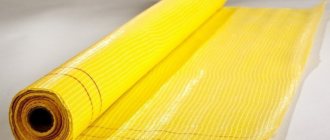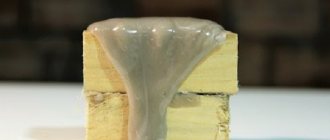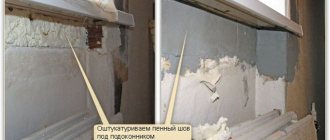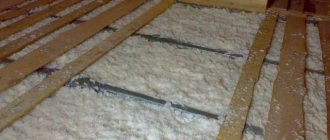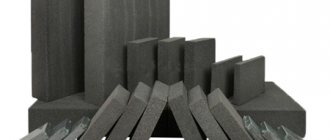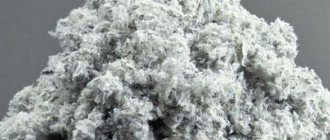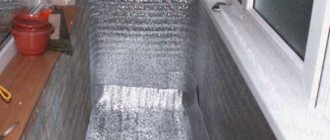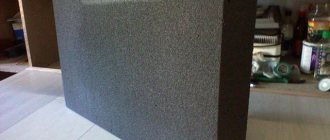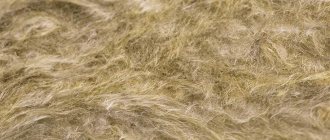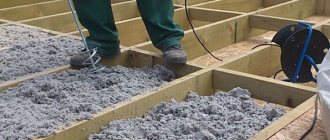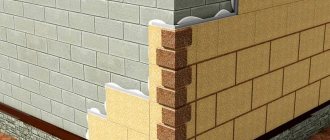A lot of cheap counterfeit products have appeared on the construction market; unscrupulous manufacturers care little about compliance with GOSTs; the products do not meet either technical specifications or environmental safety standards. More expensive samples from reliable manufacturers are not available to many consumers in this time of economic downturn.
The population of the country, looking for cheaper solutions in the field of insulating their homes, and, more importantly, more environmentally friendly for health, are increasingly starting to make insulating mixtures with their own hands, one of the components of which is sawdust.
Sawdust as a reliable insulation for the surface of walls of frame houses
Why is sawdust not used for insulation in its pure form?
Clean, only obtained sawdust cannot be used for insulation of premises for the following reasons:
- walls made of sawdust are a wonderful place for arranging homes for rodents, as well as the appearance of various kinds of microorganisms;
- After some time, the wood material cakes, voids appear in its mass - it begins to rot and more of its thermal insulation properties are lost.
Of course, sawdust is a good solution for insulation - they have a low heat transfer value. However, they must be used wisely, correctly, and only in combination with other binders. This will avoid the negative consequences discussed earlier, and then such insulation will compete with industrial products.
Building materials using sawdust
Sawdust is used not only for insulation of walls and other parts of the attic, but also for the production of building materials with good insulating characteristics.
Sawdust concrete
Sawdust concrete contains fine shavings, lime, cement and sand. Its density depends on the ratio of the components. Depending on the technical characteristics, the product is used for the construction and insulation of internal and external walls of dachas, cottages, residential buildings, attics, garages, and outbuildings. Fences or pillars for them are built from sawdust concrete and used to strengthen the foundation.
The material is well processed; various decorative materials can be used for its finishing. If it is manufactured in accordance with technological requirements, then its properties include high fire resistance and resistance to low temperatures. Sawdust concrete provides good sound insulation of attic walls, is easy and quick to install, has a low cost, but slowly gains strength and requires reliable protection from moisture.
Arbolit
Arbolite blocks are made from a mixture of wood chips, cement, and sawdust. The advantage of the product is its high thermal insulation property, strength, and fire resistance of the walls. The block is easy to process. Wood concrete does not crack, even if it is not stored under a canopy, but is subject to slight shrinkage. The product is relatively light and environmentally friendly.
The disadvantage is the inaccuracy of the geometric shape and low resistance to moisture. For finishing wood concrete, only those products that can allow air to pass through are used.
To understand which insulation is best for the attic, you need to decide on its purpose and seasonality of use. Using sawdust, you can well insulate a given room and ensure its impeccable technical characteristics for many years.
Despite the emergence of a large number of different modern insulation materials, sawdust insulation does not lose its relevance. This is an environmentally friendly and inexpensive material with good thermal insulation, which is most often used during the construction of private houses. You can prepare insulation from sawdust yourself or purchase it ready-made from a woodworking enterprise. Before using such material, it is worth studying in advance how to use it and the installation process, which has its own nuances.
The most popular types of binders
Astringent connectors for wood shavings can be substances that are well known to many, such as: Portland cement, clay, gypsum mixtures, PVF glue, as well as cow manure.
Binders in construction
- Clay is the most inexpensive material, and if you have access to nature, it is completely free. It is a completely natural substance, therefore environmentally friendly - during the drying process no chemical reactions are present, only moisture evaporates. Clay is light in weight, quite strong, but fragile and durable. The only drawback is the fact that unfired clay is not resistant to excess moisture - it begins to limp.
If we compare the clay composition with sawdust with others: gypsum, cement, then it is practically not inferior to them.
- Portland cement is the most common binder that is widely used in professional construction. The only negative is the long time it takes to harden (stand up).
Cement using wood chips is excellent for thermal plaster of walls, both internal and external. The risen cement perfectly resists high humidity. Backfill walls are a profitable and reliable way to conserve heat in your home.
- Gypsum is an ideal means for “high-speed” construction for interior wall decoration. This composition sets up almost instantly, and gains strength similar to cement. The hardened mixture is durable and environmentally friendly.
- Polyvinyl acetate is a hardened PVA glue, insoluble in water, very durable, even cruel.
For this reason, PVA is used in places with high humidity, as well as in places with direct contact with water. Cured glue has one remarkable property - it allows water vapor to pass through, so the treated walls will not only be insulated, but will also “breathe”. It should be noted that when the insulation is heated strongly, moisture will come out of the sawdust and it will dry out, but the deformation of the PVA is sufficient to retain the settled wood particles without loss of shape and overall strength.
- For lack of anything better, cow dung will do. It was widely used until the 19th century. The house was insulated using this natural glue. Today, few people use it to insulate their homes, but it is quite suitable for a barnyard. Its strength is certainly lower than that of all the above-mentioned means, but placed in the inter-wall space of an outbuilding it will work for many years.
Making sawdust mixture
There are no exact recipes for making such mixtures. All of them are prepared individually. But an approximate composition that is suitable for insulating a house in many cases is as follows:
A sawdust block is made from sawdust and a binding solution.
- Mix 9-10 buckets of sawdust with 1 bucket of lime.
- Add 8-10 liters of water with boric acid or copper sulfate diluted in it (as an antiseptic). Water must be added gradually, and its final amount will depend on the initial moisture content of the sawdust.
- Infuse the prepared mixture for 5-10 minutes. Next, fill it. It is very important that the walls remain steam-tight. Therefore, you cannot use roofing felt or linochrome; it is better to use glassine.
The resulting mixture must be laid in layers. The layer should be small and be 25-30 cm. It should be laid evenly and then compacted. After compaction, further layers need to be laid until the internal space is filled. In some cases, you can use a mixture of sawdust and lime. This insulation composition will cost more than previous compositions. But it will have less hygroscopicity. This means that it will cake less and will require less bedding in the future.
Application of various auxiliary components
The principle of operation of insulation is the same - the wood base, containing small inclusions of air in its structure, is mixed with a binder mass, which, after drying and gaining strength, forms a monolith.
Each composition has its own properties: rising time, viscosity, elasticity, which can be transformed with the help of additional substances. Each composition has its own nuances and its own solutions for specific tasks.
- So, to insulate the floor, sawdust is used instead of mineral wool. To increase their service life and reduce the rotting process, they are knitted with PVA glue with the addition of an antiseptic solution.
- If you need to pour it into a mold, add a small amount of Rotbant or TG to the cement-bonded mixture to speed up the setting. So, if you add a glass of gypsum to a bucket of the mixture, the cement will set within 1-2 hours.
- The same method works with lime compounds.
Application of pressed sawdust
Pressed sawdust is suitable not only for heating; it is also used as insulation in private buildings and bathhouses. Special boards made from wood fiber and sawdust processed by pressing are superior in efficiency to standard sawdust. Antiseptics or fire retardants are always added to the material for their creation, which increase the resistance of the slabs to negative influences. Their installation is carried out in a few hours, but such slabs definitely require additional coating.
Binders and their proportions
To prepare the sawdust mixture there is no need to experiment, all the recipes have long been known, the proportions have been selected.
Gypsum
To fill, do the following:
- sawdust is placed in the prepared container (no more than 1/5 of the container);
- in a ratio of 1:10 or 1:5, gypsum grade 1 and gypsum grade 2, respectively, are added to the base and mixed;
- add water at the rate of 1 liter per 1.4 kg of gypsum and mix;
- the mixture does not need to stand; it is immediately poured into the prepared form.
For plastering work, the preparation of the working solution differs only in the amount of water: 1 part water to 2 parts gypsum.
The solution must be prepared in small quantities, since it rises quickly, and the prepared solution cannot be diluted. However, you can use a retarder; casein (carpentry) glue is used as the latter.
As an analogue of the casein retarder, you can use hide glue with lime. Retarder recipe: soak 1 kg of glue for 24 hours, add 2 kg of lime and cook in a steam bath for 4-5 hours. The resulting retarder is added to the mixing water at a rate of 1 to 50. The setting time of the solution increases by 20-30 minutes.
Video about super insulation:
Cement
For beginner plasterers, the most preferable option is “mud” with Portland cement. The solution lasts indefinitely, up to 2-3 hours, so you can plaster it slowly. It can also be reanimated, the main thing is not to let it completely dry out or settle. As it thickens, add a small amount of water to the prepared mixture and mix. Sometimes the unused solution is left overnight, filling it with water, but it depends.
To improve (preserve) the thermal insulation properties of the wood base, various plasticizers are added to the cement, which increase the plasticity of the composition. As the latter, use liquid soap, shampoo or inexpensive dishwashing detergent. Adding a soap additive can also reduce the amount of water used. The amount of additive is measured by eye: a cap will be enough for a bucket; after a couple of batches, even a child will figure out the amount of additive.
Insulation using a solution with sawdust and cement, as well as soap solution, is not recommended, since after rising the mixture does not allow moisture to pass through, and you will end up with damp walls, ceiling and floor.
For indoor work, it is better to use industrial additives such as polyplast, fort or superplast - they are more effective than soap or milk.
Milk is used in the same quality as other plasticizers, but it should be remembered that when using it, cement will lose strength.
Plastering walls with a mortar containing sawdust
Lime
A very necessary and useful substance in the household. Lime is an alkali that is a natural antiseptic. However, it can not only wash clothes, but also disinfect shavings from various microorganisms and their larvae. In addition, the alkali will rid the base of the solution of rot and will protect it for a long time from the appearance of unnecessary organisms, including rodents (they are afraid of it like fire).
To use, you only need slaked lime (so as not to injure yourself). You need to mix lime with sawdust in the following proportion: 1 part lime to 10-15 parts sawdust.
Important! Wooden frame walls treated with lime mortar will be more durable. Neither bark beetles nor all kinds of aphids will grow in them.
After treating the sawdust with lime, you can add any other binder.
It is possible to use lime as an adhesive composition, but the performance will be unimportant, and besides, it is better not to use it inside a living room.
Lime will also work
Clay
Another folk forever young material. It has been used throughout human history. By mixing clay with straw you can build a mud hut. The properties of clay are unique, and, in addition, it is very affordable.
Clay as insulation for house walls
The following proportions are recommended for insulating a house:
- For the ceiling and floor - 1 part diluted clay and 10 parts wood waste;
- For insulating walls, for filling internal cavities, - 1 to 5;
- To plaster walls, you need a more viscous mixture - 1 to 2.
The readiness of the clay solution is determined by touch; it should be slightly greasy and elastic. If the pieces stick strongly to the trowel, then the solution must be combined with shavings.
Clay compositions are the most suitable for human life. They are environmentally friendly, durable, the main thing is to protect products made from unfired clay from direct exposure to water. Insulation with clay and sawdust is a common phenomenon.
The life of the prepared composition is endless; if the clay has dried, just add water, and it will be fine again.
You can buy clay at any hardware store, but you can also get it yourself. You should know that the best clay is located at a depth of at least 1.5 meters, since its upper layers may contain particles of plant roots, and this is not welcome.
To fill walls with clay, the composition should not be liquid or even creamy, otherwise drying will last indefinitely. Clay lumps with sawdust should be moist and slightly crumbly so that they stick together when compacted.
PVA glue for walls
To prepare thermal insulation material, you need universal or construction PVA; other brands of adhesive for thermal insulation are not suitable.
The wood raw materials for the mixture need to be dry and, if possible, fresh. There are no clear proportions; the solution is prepared by eye - approximately 1 to 5-10. The smaller the amount of glue used, the lower the heat transfer of the composition. But you shouldn’t be greedy either, because poorly processed shavings will rot and rot.
Reviews about sawdust insulation
On the Internet you can find many different reviews about sawdust as an insulating material, but most of them are custom-made material, the purpose of which is to advertise some products or services.
the most authoritative RuNet forums as a source of reviews , where both ordinary residents and experienced builders or engineers share their opinions.
Here are links to such forums and their threads related to the discussion of the use of sawdust as insulation:
- Forumgrad.
- Artisan.
- We are building a house.
- Mastergrad.
- Forumhouse.
Advantages and disadvantages of sawdust
Sawdust, considered as a raw material for construction, has its advantages and disadvantages.
Insulating walls with sawdust: pros and cons:
- Price. This is the first thing for which this multifunctional raw material is valued. For many, the price is generally zero, whether there are any financial costs for delivery.
- An environmentally friendly material that, when used correctly, does not emit any harmful substances. Chemical contamination is completely excluded.
- Durable in use. This fact has been proven by human history - many generations of our ancestors used it and did not complain.
- Installation. In order to perform any kind of manipulation with these materials, qualifications are not needed; the work can be performed even by a person who is far from construction.
- Thermal conductivity. A very low score for this parameter. The wood structure itself has tiny air cavities, which is already a universal insulator, plus the fine-grained component of the sawdust itself.
House made from waste from shavings and clay
Disadvantages of wood waste:
- Flammable Increased fire safety measures must be observed.
- Prone to rotting.
It should be noted that the existing shortcomings can be solved in various ways, including those discussed in this article.
Characteristics of sawdust as insulation
Wood has low thermal conductivity, which makes it a good heat insulator. At the same time, the layer of wooden cladding has considerable weight, creating a significant load on the insulated surfaces. In addition, the cost of such thermal insulation is extremely high. Sawdust is a waste product from wood processing that costs virtually nothing. From a physical point of view, sawdust is a large number of wooden particles; between them there are air cavities, which in themselves are a good heat insulator. The resulting combination allows for high-quality heat conservation. The density of such material is much lower than the density of solid wood, so its weight is much less and does not create a noticeable load on the supporting structures. In addition to its main function, sawdust can provide high-quality sound insulation, increasing comfort for people living in the house.
Sawdust is used as insulation for roofs, floors, walls and ceilings
The main feature of sawdust is that it is a bulk material, which limits its use to only horizontal surfaces. The solution to the problem was to bind sawdust with other components that impart rigidity and the ability to hold a given shape. Thanks to this, it became possible to use the material for any surface, both horizontal and vertical.
It is important! It is necessary to distinguish between sawdust and shavings. In most cases, the term “sawdust” refers to shavings, which have great elasticity, are able to hold their shape and retain heat. It is formed as a result of machine processing of wood using planing equipment.
Sawdust itself is small wood chips that are formed during sawing and have greater density and weight. It has a smaller volume of air layers, is prone to caking and can be compacted to a state close to solid wood.
The chip layer is looser and has less weight. The layer of sawdust is dense and heavy. When choosing a material, you need to distinguish between these types and take chips that have a more successful set of properties.
For insulation, pine and spruce wood shavings are mainly used, since coniferous species contain more lignin
Wall insulation technology
Regarding technologies, the following should be noted:
- backfill method. The mixture is poured onto a solid base or placed inside two surfaces where it is compacted;
- pouring. A relatively liquid solution is poured into a prepared mold, where, as it dries, it acquires the properties of a solid monolith;
- plastering. If the walls are plastered with sawdust mixture, they acquire thermal insulation properties.
Thermal insulation blocks

